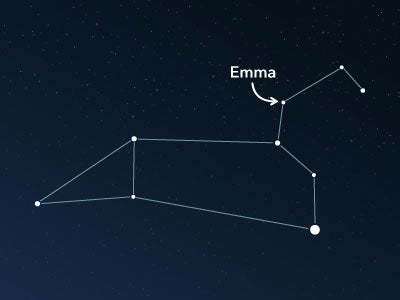The constellation Leo
Caractéristiques
- Nom latin
- Leo
- Hémisphère
- Les deux hémisphères
- Visibilité
- October - May
- Région
- 947 deg²
- Étoile la plus brillante
- Regulus (HIP number 49669)
- Spécialités
- Galaxies

The Leo, Latin for Lion, is mainly known from astrology as it is one of the 12 zodiac signs. It is also one of the 48 constellations described by the Greco-Roman astronomer in ancient times. In its area are several interesting deep-sky objects that can be observed.
Hemisphere, visibility, and area
The constellation Leo stretches across the celestial equator and is, therefore, visible in both hemispheres. It can be seen from 84° N to 58° S. In northern regions of Greenland and some island groups, it is invisible. In the southern hemisphere, it can be observed as far south as the southernmost point of Patagonia and a few nautical miles further south. It is only not visible from Antarctica and the surrounding islands.
The best time to observe Leo in the night sky is from October to May, with April and May offering a particularly good view of the constellation.
As Leo is located on the ecliptic, the sun passes through the constellation every year from August 11th to September 17th. At this time, the constellation cannot be seen as it rises and sets with the sun on the horizon.
Compared to the zodiac sign Leo, which is assigned to people born between July 23rd and August 23rd, the path of the sun is now shifted by about one month due to the precession of the earth.
Leo covers an area of about 947 square degrees and is therefore ranked 12th among all 88 constellations.
In the area of the constellation, there are some striking stars, with the brightest of them being Regulus (Latin: α Leonis, Alpha Leonis) with an apparent magnitude of roughly 1.36. It forms the well-known Spring Triangle with the stars Spica and Arcturus.
The Leo constellation is surrounded by nine neighbors. The Cancer and Virgo constellations border along the ecliptic. Other neighbors include the Leo Minor, the Hydra, and the Sextans. The Crater, Coma Berenices, and Ursa Major (well-known as Great Bear or Big Dipper) are also adjacent constellations. Additionally, Lynx is located next to Leo.
Specialties in the constellation
There are a number of galaxies in the area of the constellation Leo.
M65 (Messier 65) and M66 (Messier 66) are two of them. They were discovered by the French astronomer Charles Messier in March 1780. Together with another galaxy, they form the so-called Leo Triplet, the core of the M66 galaxy group. Their distance is estimated to be around 30 million light-years from earth.
Even in a large and bright binoculars, the individual galaxies can be perceived. The group is located southeast of the star Chertan.

Mythology and history
The first interpretation of the constellation dates back to ancient Egypt. At that time, when the sun passed through the constellation every year, the lions simultaneously migrated from the desert to the sandbanks of the Nile. Therefore, various ancient people saw a lion in the constellation.
In Greek mythology, the lion is mentioned in connection with the hero Hercules. The constellation is said to represent the Nemean Lion, which plagued humans and the environment near the city of Nemea in Corinth.
According to legend, Hercules was tasked with killing the lion as the first of his twelve impossible tasks. However, his attempt to shoot the animal with arrows failed miserably, as the lion was equipped with a unique fur that made him invulnerable.
But Hercules did not give up and eventually managed to strangle the lion. He then used the lion's own claw to slit its skin and wore it as a protective mantle from then on. At the request of Hera, Zeus set the lion as a constellation in the sky.
PubliéLire d'autres articles intéressants

An overview of all 88 constellations
Learn more about all 88 constellations and read interesting information about the mythology, visibility, and features.

Application Planétarium
Découvrez le ciel nocturne avec notre application de planétarium !
Disponible pour iOS et Android.

Nommez une étoile dans la constellation Lion
Name a star in a constellation and create something that lasts for eternity.